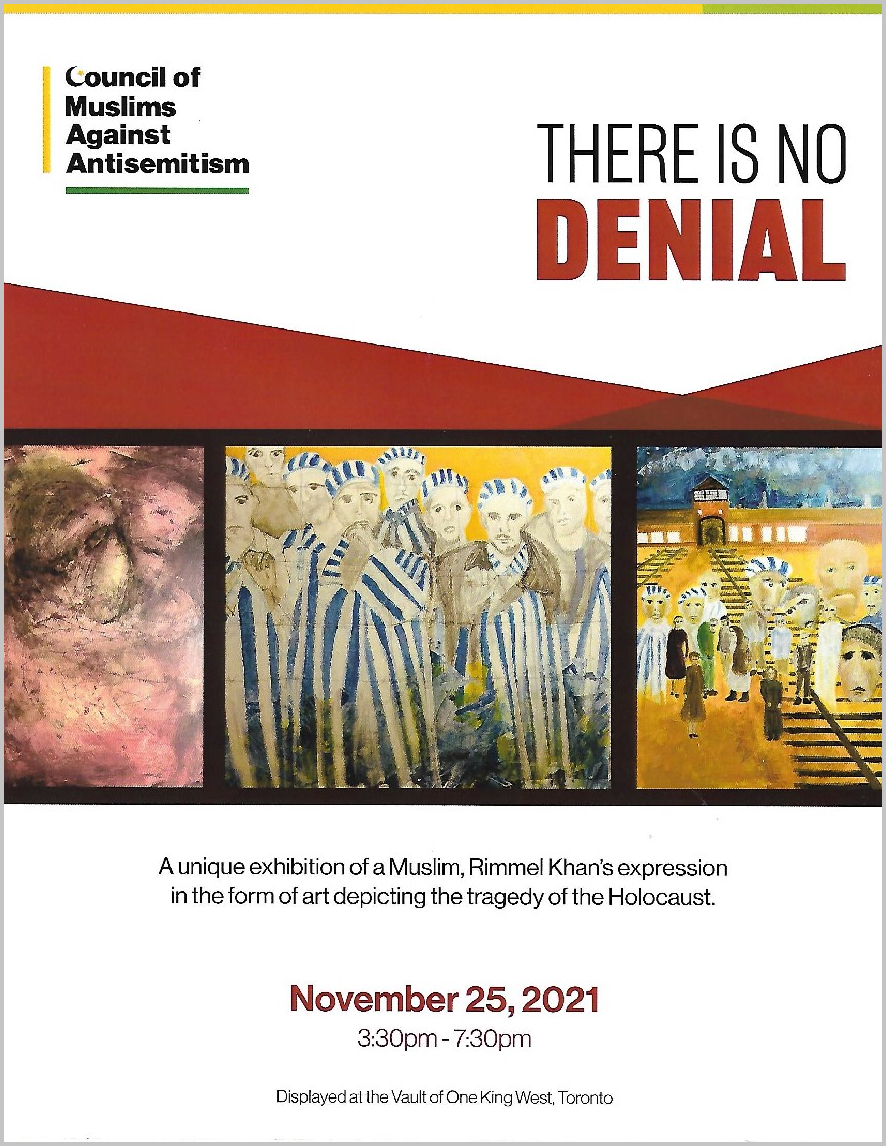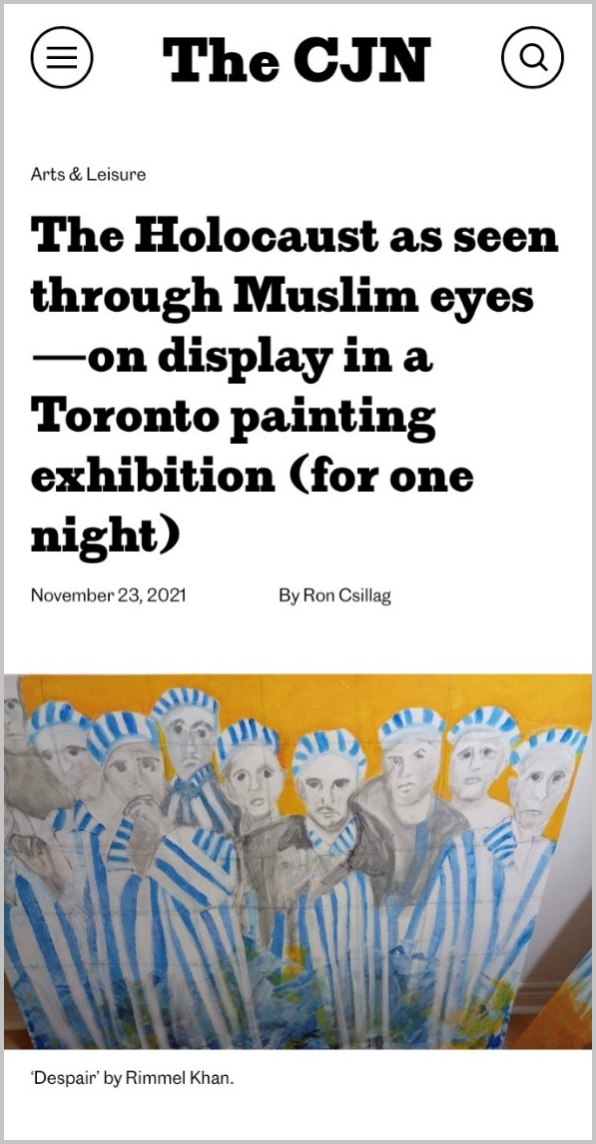A unique display of artwork of the Holocaust as seen through the eyes of a Muslim Artist
 The Invitation
The Invitation“To forget a Holocaust is to kill twice” (Elie Wiesel)
Date: Thursday November 25, 2021
Viewing: 3:30 pm to 7:30 pm
Venue: The Vault, B1 Floor, One King West, Toronto, Ontario M5H 1A1
Speakers: Zenji Nio, Guido Smit and Raheel Raza and Ariella Daniels from the Israeli Consulate in Toronto
Also Supported by
ALL COVID PROTOCOLS REQUIRED BY THE VENUE
 The CJN: CMAA Holocaust Exhibit
The CJN: CMAA Holocaust Exhibit“[… Rimmel] said the CMAA discussed putting on an event for Holocaust Education Week as a way of helping to fulfill its mandate of combating antisemitism .“We all came up with the idea of doing something a little different: A Muslim painter—and I use the word ‘painter’ very loosely—to express how one feels about the Holocaust. ”The Holocaust has “always fascinated me and intrigued me.” Khan said he may have first encountered the subject at the Catholic boarding school, run by Irish nuns, that he attended as a boy in Pakistan. Muslims who could afford it considered it the best education.
“Religion was a very universal thing for me,” Khan said. The subject then became “self-taught, self-learned,” and a result of a lot of reading, most recently online. In Pakistan, the Holocaust “was never really something in our minds.” While his native country’s educated class is aware of the Holocaust, others have “no clue. It isn’t even that they don’t believe it, they don’t know about it. He’s not aware of any other Muslim artist who has depicted the subject. “I guess (it’s) because it’s such a taboo in Muslim countries.”Khan said he’s been to Israel a few times. “To me, that’s a society I wish Pakistan would have been.” He said the project has deepened his understanding of the Holocaust.“ It has changed me to a feeling of empathy and a more real understanding of the darkness man is capable of.”
Raheel Raza, the Canadian activist who is playing a leading role in the CMAA, said that given her organization’s mission to push back against antisemitism and in light of the Abraham peace accords between Israel and Muslim nations, the council felt that it “should do something that has never been done before. We saw (Khan’s) paintings and said, ‘these need to be exhibited.’”
By Anne Howard
Growing up in Israel, one of my earliest childhood memories is of the siren heard all over Israel on 10:00 AM on the national Memorial Day commemorating “Holocaust and Heroism”. The siren is heard for two minutes in morning where the nation stops. No one makes calls and no one answers the phones, in fact the phones never ring in those two minutes. It's just silence that can be cut off sometimes by the crying of babies and chirping of birds and other animals around you.
Citizens from all religions stand up in silence and solidarity: at schools, the streets or work and wherever the siren catches them. Holocaust is commemorated through out the year with activities, exhibitions, film screenings, history books, in the education system & academia and all walks of life.
 Creating awareness of the most horrific and tragic chapters of in our history: the Holocaust is very important to all Israelis regardless of religion. They support it no matter where they are on the globe, so when I first heard of the exhibition help by the Council of Muslims Against Antisemitism recently in Toronto showcasing the works of Canadian artist of Pakistani origins Rimmel Khan entitled, "There is No Denial" I felt both honored and obliged spread the word about the exhibition, and I knew that I had to be there and see the artwork for myself.
Creating awareness of the most horrific and tragic chapters of in our history: the Holocaust is very important to all Israelis regardless of religion. They support it no matter where they are on the globe, so when I first heard of the exhibition help by the Council of Muslims Against Antisemitism recently in Toronto showcasing the works of Canadian artist of Pakistani origins Rimmel Khan entitled, "There is No Denial" I felt both honored and obliged spread the word about the exhibition, and I knew that I had to be there and see the artwork for myself.
The relationship between Israel and Pakistan can be described as frosty to non-existent at best, there is no cooperation between the two countries, so the exhibition piqued my curiosity. I found it interesting to discover what would be the perspective of artist that grew up in a Muslim, Pakistani culture, in a country that forbids its citizens to visit Israel, on human tragedy such as the Holocaust. and indeed, the exhibition turned out to be a very emotional and unique experience, not only for me but also to other people attended.
 It is very moving to stand in front of a painting, knowing that the artist rose above the dictate of culture and religion to reveal his raw emotions and humanity and by extension we also rise above ours by our show of solidarity with the victims and the artist. Holocaust events are so ugly, I understood that from a young age but Rimmel‘s paintings begin with unusual, beautiful colours. he wraps the horror in a very poignant, human way, which makes it more traumatic to watch and gives us nervousness followed with a sense of urgency, that we cannot absolutely let it happen again.
It is very moving to stand in front of a painting, knowing that the artist rose above the dictate of culture and religion to reveal his raw emotions and humanity and by extension we also rise above ours by our show of solidarity with the victims and the artist. Holocaust events are so ugly, I understood that from a young age but Rimmel‘s paintings begin with unusual, beautiful colours. he wraps the horror in a very poignant, human way, which makes it more traumatic to watch and gives us nervousness followed with a sense of urgency, that we cannot absolutely let it happen again.
The show of respect by the artist is felt through his choice of scenes seen in his paintings, that together can be combined into a unique storytelling all the events that happened. it is a timeless way of creating awareness off the atrocities that occurred, for generations to come.
The artist heavily used orange, yellow and mustard with purple and red. I found the colours used in the paintings very familiar, but I could not place it. all I felt is that orange and red gave me a sense of danger yellow means usually hope and mustard confusion and purple made me feel sad and eerie.
I could recognize the striped uniform that the characters in the painting wore, after all I have seen it hundreds of times before, in pictures and movies and history books but I something was missing something that I could not place yet. Rimmel explained that instead of using the yellow star of David- a symbol that was forced upon the Jews to wear in that period, he felt it would be more fitting to use the colours in the background and not enforce it on them in his paintings. and indeed, his choice of not showing the start of David, to me symbolizes his empathy with those victims, and they have the right to be treated as human and to be celebrated and immortalized.


 This made me do another take on all the paintings, this time with the artist's perspective in my mind and reflect on my feelings and I found that the men and women in his painting did not seem to me like victim to me from the moment I entered exhibition. The vibrant colors made me look at their faces instead of their victimhood, they seemed more normal and human than the victims in any picture I remember of Holocaust photos.
This made me do another take on all the paintings, this time with the artist's perspective in my mind and reflect on my feelings and I found that the men and women in his painting did not seem to me like victim to me from the moment I entered exhibition. The vibrant colors made me look at their faces instead of their victimhood, they seemed more normal and human than the victims in any picture I remember of Holocaust photos.
The artwork in the exhibition tells a remarkable tale of survival, while showing the artist's raw emotions and evoke in us the viewers mixed feelings of horror and gloominess by horrific scenes that it's trying to depict and feelings of hope knowing that humanity fought back and that victims were freed.
One painting in particular, of a mother carrying a child on her back in shades of red and yellow blending them with their background, brings to life similar images that we've seen many times in the news off refugees fleeing were sticking areas and genocide around the world. it stands as a reminder that history can repeat itself, it reminds us of the horrors that can happen despite the fact that the Nazis were abolished evil still roams the earth and we cannot afford to turn the other cheek on it.
After all, the Holocaust is an established historical fact with irrefutable evidence from a multitude of sources and witnesses who testify both to the magnitude and atrocity of the crime.
As for anti-Semitism or the hatred of any group of people, this is unequivocally condemned. by bringing in awareness to the Holocaust hopefully lessons of past experiences can be gained. and an outcry can be heard wherever an ethnic cleansing and genocide occur. We should stand for justice, stand against Antisemitism, stand against the oppression of humans regardless of their Religion, Ethnicity or Gender . just because “the other” “the different” “ the forsaken” “ the poor” also has the right and deserves to live to live and die according to their own terms.
“Globalized antisemitism is a thriving international enterprise that transverses cultures and civilizations. You can help us fight the this most enduring, pervasive, and lethal mode of hatred.”
Raheel Raza
Donate“No other widespread prejudice has characterized people as such cosmological threats…. No other prejudicial discourse has been so eliminationist or produced such regular calls for violence and extermination.”
Prof. Daniel Jonah Goldhagen
Learn MorePlease, enter a valid value